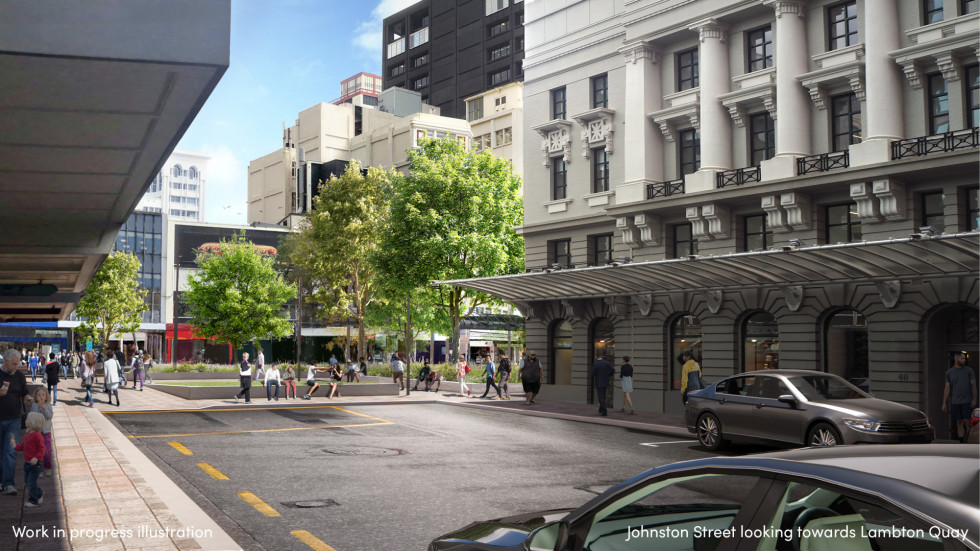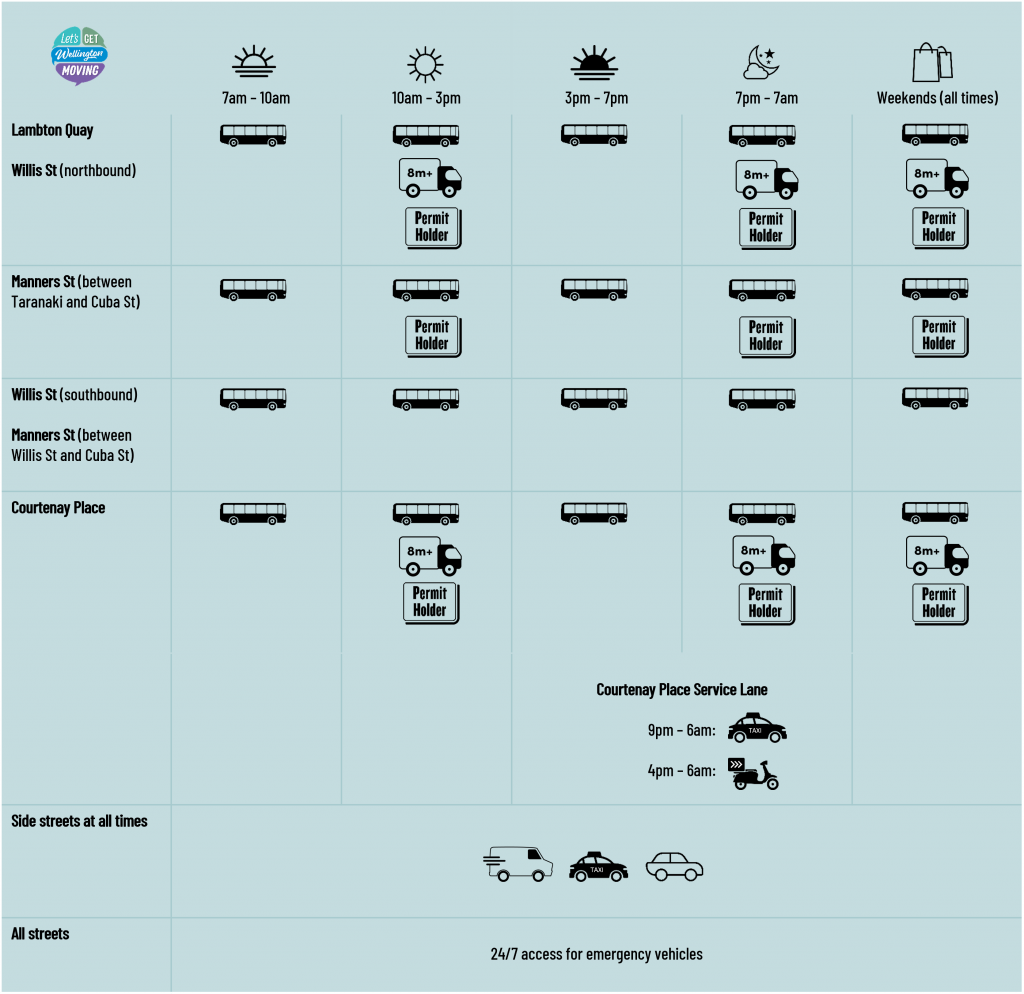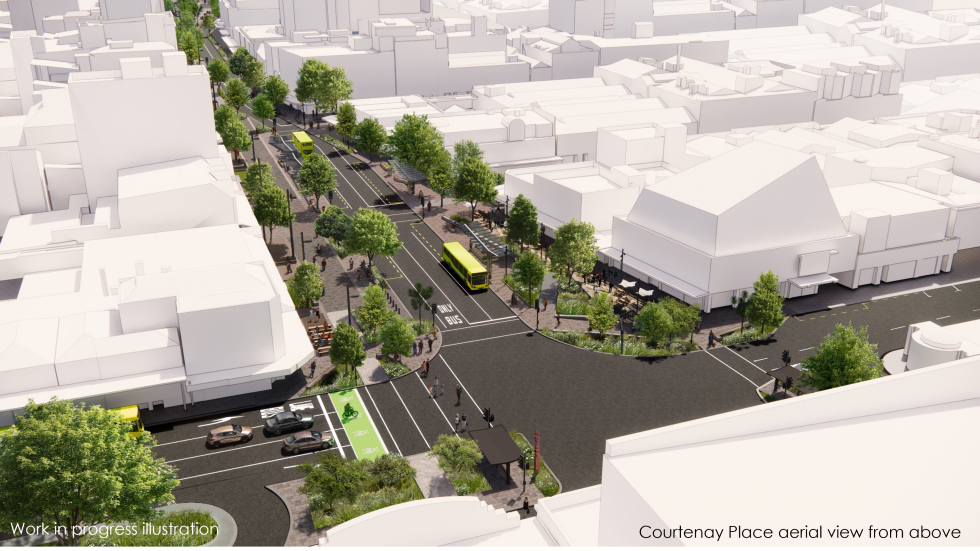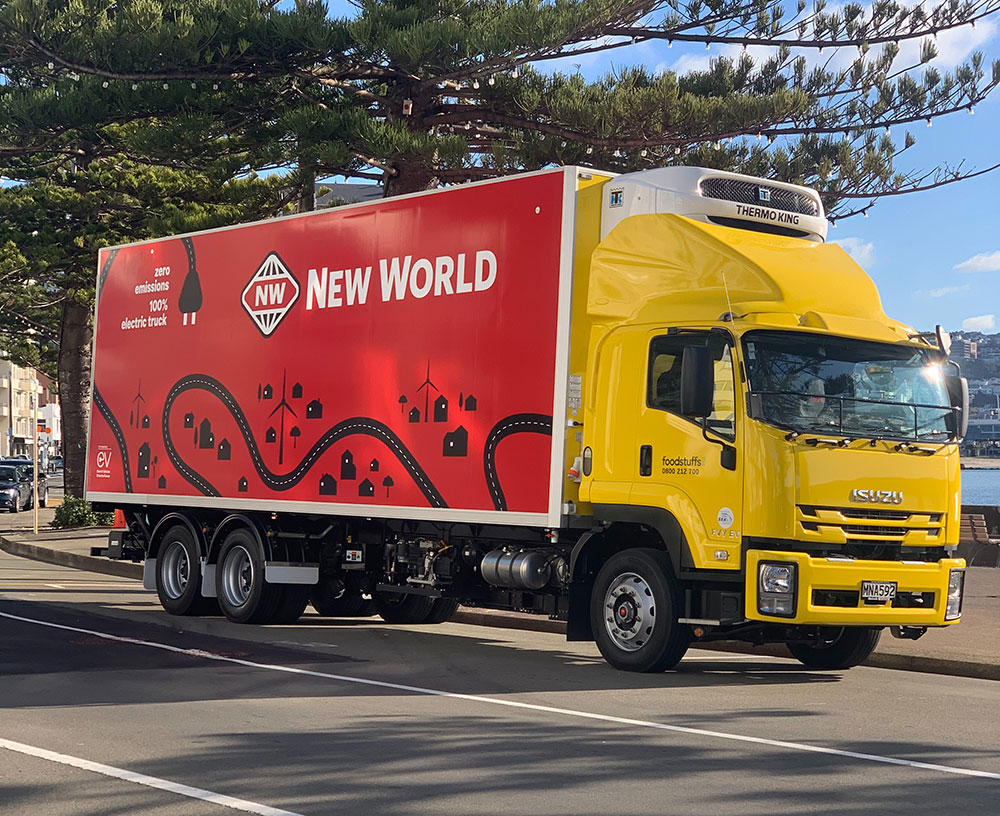Golden Mile feedback window closing soon! Your guide for feedback…
The plans for Golden Mile are coming into focus! There’s still time to provide your ideas and feedback on their details. Hop on LGWM’s interactive map or flick them an email by August 14th to have your say!
Let’s Get Wellington Moving (LGWM) has been moving slowly forward on a better Golden Mile for some time now. The specifics have been increasingly narrowed down and fleshed out.
If you have an opinion on an aspect of where they’re heading (positive, negative or otherwise) we encourage you to share it! LGWM is accepting feedback on the details of their Golden Mile plans until 10 pm August 14th. That’s this Sunday!
You can send feedback by emailing goldenmile@lgwm.nz, calling 0800 110 130 and hoping someone takes notes, or leaving a specific comment on their interactive map.
We’re moving forward
It’s great to see that things we’ve already been consulted on (and resoundingly said we want) aren’t being re-litigated.
“The big changes have already been confirmed:
- Private motor vehicle access will be removed from the Golden Mile
- Existing on-street parking on the Golden Mile will be removed allowing for the widening of footpaths
- Access to the Golden Mile will be closed at side streets making them cul-de-sacs. This includes the ‘Golden Mile ends’ of Blair Street, Allen Street, Cuba Street, Mercer Street, Ballance Street, Stout Street, Waring Taylor Street, Johnston Street, Brandon Street, Panama Street
- Parking layouts on the side streets will change”

This all means life will be a lot easier for you if you want to cycle, scooter, walk, or take any other active transport through town. There will still be options and parking for private vehicles, but access will be limited to side streets and these cul-de-sacs. All good moves, and it’s a great relief LGWM is moving forward on those fundamentals.
What’s being proposed?
LGWM looking for input on specific designs, policies, favourite features and key flaws. Right now it’s all about the details. So why don’t we get into them?
What gets to go where, when
The big move here is essentially private-car-freeing the Golden Mile (“removing general traffic”) from a route between Bowen Street and Cambridge Terrace.
Which is 100% sensible for the heart of a modern city… but then there’s plenty of carve-outs in the proposal.
Our tolerance for these depends on:
- how much we trust LGWM / WCC / whomever else to keep the momentum going (so things that are subsequently changed will be enhancements, not backslides)
- how much change we believe the city will keep sailing through (or what kind of proverbial eggs, and how many, it’s OK to break in the creation of this very long-overdue omelette).

It’s worth using the above as a lens for your feedback. Below, we go through the main aspects LGWM are seeking feedback on, and in italics is what we suggest you emphasise in your feedback (by 10pm Sunday).
Light commercial vehicle access
Couriers, trade and light delivery vehicles will largely no longer be able to access the Golden Mile. These and rideshare or taxi services will have to use side streets and loading zones. For the big ones… more on that below (Deliveries and logistics). We’d also like to see something that would stimulate the growth of light, low-impact mobility services…
Taxis and rideshares will be able to use a service lane on Courtenay Place between 9 pm and 6 am. This is to ensure people have a safe ride home if they’re out late. Motor-scooters will be able to use this service lane for food delivery daily, between 4 pm and 6 am.
Support.
Buses and bus stops
Key changes to the bus service are dedicated bus lanes, bus stops spaced such that they’re a short walk from each other, and better shelter and waiting facilities at said stops. Two pairs of stops will be on Lambton Quay, one pair on Willis Street, one pair on Manners Street and one pair on Courtenay Place.
Dedicated bus lanes are absolutely crucial for a service that actually functions to be competitive with private car driving. Strongly support! (Get on with the Bus Priority Action plan already, so we have better PT before we die of old age waiting for LGWM to do mass transit.)
Easy access to the bus, and to the Golden Mile generally, is vital. But bus services are already pretty dire to use if you’ve got a disability. At least for the central city end of the journey, we’d love to see something that’ll stimulate the growth of light, low-impact mobility services like these helping people with impairments get throughout Ljubljana’s fully pedestrianised streets (no buses go in).
LGWM is currently considering who can travel in bus lanes and where people biking/scooting will be able to travel.

Cycle paths for people biking, scooting or skating
Lambton Quay and Courtenay Place will get dedicated cycle paths. On Lambton Quay, the pathway will run between Parliament and Panama Street… and then… There will be a “shared space” along the aforementioned Courtenay Place service lane. This means that when it’s actually allowed, people who bike, scooter, skateboard etc. will share the lane with Ubers, Zoomys, taxis and food delivery services in the evenings. Cycle Wellington has an excellent summary of this and the other issues, and suggested responses.
We agree with Cycle Wellington that is a pretty gappy way to do a “bikeable network”. Depending on how trusting you are that the powers that be will have their act together, you could be more or less tolerant of what’s proposed. LGWM say they will be “carrying out further investigations into future connections as part of the LGWM City Streets Programme and as part of other initiatives such as the Botanic Garden ki Paekākā to city route, and the Newtown to city – WCC Transport Projects“.
If, like us, you’re less than fully trusting of the commitment, we suggest you weigh in on this bit to give a boost to a bikeable city.
If you’re short on time we’d suggest you say “provide a connected, consistently safe bike and scooting route through the central city through all stages of LGWM”
and/or Cycle Wellington’s “general feedback” summary:
- “I support these plans to transform Wellington’s Golden Mile. Get on with it. This work will improve liveability, cut carbon, and make our city a safer and more pleasant place.
- I am concerned about the incomplete cycling route, lack of connectivity with side streets, ambiguous separation from pedestrian areas, and frequently, suddenly dropping from bike lanes to shared spaces. Until quality separated routes for cycling are delivered on the Golden Mile or nearby streets, people on bikes should not be excluded from any of the bus lanes.”
Private motor vehicles – personal cars, SUVs, utes…
Most of the press is about parking and there will be far fewer pay-and-display car parks on side streets. But given the great majority of people already accessing the Mile do so without parking a car nearby, this is a straight-out Support. Meanwhile, new mobility parks close to the Golden Mile will be a priority. Support.
On all this, the project is looking for input on where best to put mobility car parks and how to best ensure accessibility. They’re also keen on feedback on their permit system and hours. We have some for them!
Here’s one of the interesting carve-outs from the “car-free” Golden Mile:
LGWM is proposing that certain (permit-holding) private vehicles can still gain access to the “carfree” Golden Mile between 10 am and 3 pm and at night between 7 pm and 7 am. They say “this is to prioritise public and active transit during peak hours. At the weekend, permits will grant access at all times.”
We can only assume this includes mobility pass holders, and (because LGWM have said “private” rather than just “mobility vehicles”,) that there are residents who have cars living on the Mile who have garages in the buildings. We can also only assume that there aren’t very many of these, and the “carfreeing” won’t be undermined by the permits being handed out willy-nilly. Otherwise, the whole “carfreeing” thing would be a bit of a farce. How much do we trust LGWM? Hmmmmm.
People living in the area – of which there will hopefully soon be thousands more – should not have privately-owned cars stored on the Mile if a car isn’t essential to overcome an impairment. Golden Mile residents who’re able-bodied can have carshare (dedicated/private to their buildings) or keep their cars in garages on any of the other streets nearby which – lest we forget – will still be very car-friendly for plenty of years to come.
We suggest you say: essential accessibility for people living with impairments should be the only private vehicle access to the Golden Mile that’s permitted by default. There should be strict limits on the numbers of permits handed out to private car owners without mobility passes, and a sinking lid on these.

Logistics and deliveries: go harder, get smarter
This has been one of the most fraught aspects of the debate, and the aspect of retailer complaint that has the most merit (which in contrast to protests about customer access, is being based largely in facts).
Effective and efficient deliveries and logistics are what make cities tick. It’s absolutely vital to have a system that works well.
But the Wellington logistics scene is still rollin’ like it’s 1975. For the “innovative city” you can’t spot any of the top 4 very commonplace logistics innovations being used (except for the stalwart Nocar Cargo, still battling away and being awesome).
And if you’re already hearing the righteous gnashing of teeth from the Road Transport Forum et al, think for a moment: in many of our towns, the nicest, safest, freest space for people to wander about, to shop, meet friends, get some food, bring the family is… the shopping mall. And you never see a truck inside a shopping mall, despite them having (proudly) all the things a good city centre should have, and businesses functioning well with plenty of stock when they need it.
Why? It’s no coincidence: trucks ruin the experience of the public realm. So we should keep the trucks and the people separate in time and/or space, as much as we possibly can.
Perhaps to appease the retailers for (we reckon) doing far too little legwork with retailers and delivery companies, the current LGWM proposal for big trucks is this:

Soooooooooo.
Two things here. Yes, this will be a bit better for the appeal of the Golden Mile: the side streets’ being made cul-de-sacs (aka being “Bond-Street-ed” and “Grey-Street-ified”) will mean some of the largest trucks can’t go through there anymore (not least because turning around to get out again will be impossible).
But you’ll still be able to drive your whopping great curtainsider truck down Lambton Quay, Willis St, Courtenay Place at lunchtime every day and throughout the entire weekend. Yep, the proposal is for trucks explicitly over 8 metres long to have access by default to the Golden Mile, except for two little 4- and 5-hour windows. So when our streets should be absolutely buzzing with people, you’ll be able to navigate your bijou nimble little refrigerated 10-wheeler amongst them.

This is pretty bonkers.
Firstly, it will delay the point at which Wellington’s delivery and logistics market steps up and starts innovating. The supercharging of market innovation into smaller, lighter, nimbler, less polluting and more efficient delivery vehicles overseas has been effected by only one thing: regulators drawing hard lines. It’s the EU and cities with emissions rules, and it’s the cities again saying “you don’t get to bring that great big thing in here anymore (even if it is electric”). The market has responded with the ingenuity, elegance and efficiency that it does, and that innovation is far too late happening here.
Let’s simply start not by banning big vehicles entirely, but just saying “deliver at night”. Many cities such as Brisbane require large-truck deliveries to happen very early in the morning or overnight. Then our streets are free of trucks during the day when lots of people are using them. And our truck drivers are freed from the incredibly stressful situation of trying to navigate a large vehicle (which let’s not forget is full of blind spots, yay thanks NZ heavy vehicle standards) through a tight space full of people moving about and being …. people.
Genius!
One problem retailers raise with night-time deliveries is someone to receive and sign off that the goods have got to where they need: some hapless staff member has to hang out in the wee small hours and wait for a delivery. Not ok. So let’s also accelerate the development of freight consolidation hubs. These are where trucks deliver to a site on edge of city centre and then the last-mile delivery to the customer is done by cargo bike, or on foot with the cutting-edge innovation known as a “trolley”.
Many cities are developing these including Sydney, London and Toronto, for big stuff. We could trial mini ones with secure access for larger overnight deliveries that’ll sit and wait, and can be fetched by staff first thing in the morning. There can be refrigerated ones too, which can receive all those daytime deliveries for the Bidfoods / Moore Wilsons runs, that replenish the more hour-by-hour service to the hospitality businesses of the Golden Mile.
And to reduce the amount of lighter automobile logistics vehicles (AKA the ol’ Toyota Hiace courier traffic) on surrounding streets, let’s accelerate making smart delivery hubs for private packages on the edges of the Golden Mile. Again, when this is set up it’ll be far less stressful for couriers and far better for the city streets.
We recommend you say: access for large vehicles for delivering to the Golden Mile by default is totally inappropriate as it will suppress the street experience and hold back innovation. Deliveries with large vehicles (>1 tonne) should be done at night only, with special permits for electric vehicles between ~500kg and 1 tonne, and no restriction on access (but dedicated parking spaces) for delivery vehicles under ~500kg. Accelerate freight consolidation hubs and smart delivery hubs.
Enforcement
Heaps of the pretty sensible stuff (about taxis, rideshare, bus lanes etc) is reliant on enforcement.
WCC staff aren’t even able to protect legal bike lanes and footpaths right now, because there’s simply far too little enforcement resource. All this won’t be worth the paper it’s written on unless WCC supercharge parking and access enforcement, which will be unpopular and absolutely crucial. Auckland’s limp version of the Golden Mile* (“essential vehicles” exempted from carfreeing on part Queen St) has been a débacle thanks to policy-makers not notcing the scourge of the new-doublecab-ute-as-putative-work-vehicle, and ute owners’ superhuman levels of entitlement and determination to take the p*ss. Do not be so naïve as to think Wellington is immune from this.
We recommend you say: Tool up the enforcement and make the rules real!
Streetscape design
This is a key aspect of Golden Mile’s revitalisation.
“Because the Golden Mile is a place where people move slowly and dwell, local identity will strongly influence experience. We’re working closely with Mana Whenua to explore opportunities to reveal and reinforce the rich cultural heritage and identity of Wellington’s city centre for future generations to enjoy.”
LGWM
‘Unnecessary’ street furniture that may clutter footpaths will be removed. Good, as long as businesses can put stuff out that signals their openness and welcomes people towards them.
LGWM will be considering clusters of seating, shelter, water, and rubbish bins when it comes to street furniture. These will have to be easily accessible for all ages and abilities.
The current paving tiles will be replaced along large sections of Lambton Quay and Courtenay Place with something robust and non-slip. Hooray! Smaller sections will be replaced on Willis and Manners Streets.
Throughout Golden Mile, there will be more room for trees and green spaces. The aim here is to create a sustainable, resilient green street network – good to see WCC’s Greening the City policy coming into leaf. The flora planted are intended to complement Wellington’s natural ecology and climate while supporting local fauna. More tūī FTW!

As for the rest, the project is open to recommendations. If you especially want outdoor dining facilities, public art, play areas or particular green spaces, let them know!
We reckon the flimsy “bus hubs” and unprotected public realm on Courtenay are … well, a bit naïve. Yes, Wellingtonians are the country’s fastest responders to a bit of sunshine, but often it’s really quite windy. Waiting for your public transport will be pretty miserable in those feeble “shelters”.
Construction time
Businesses along the Mile are, quite justifiably, terrified at the prospect of this incredibly long, drawn-out, flipflopping pre-construction process turning into an equally long, drawn-out, flipflopping, damaging construction process. It is an awful prospect for all of us.
Here again Auckland can give us some lessons. Talk Wellington contributor Liz Allen from Place Creative has some sound advice from their central city construction works – on how we should get our house in order first, and then … have a read in this thread.
In her excellent post on this, Liz finishes with: “Get your house in order thoroughly, address challenges now, don’t waver.” Boom.
We suggest you say what she says, or just make the construction period thoroughly awesome for people to be around.
How to make a suggestion
Now that you’re all caught up, maybe you’ve got some ideas, some opinions, some considerations. What do you do now?
You have until 10 pm August 14th – that’s this Sunday – to provide feedback or advice on any of these details. There are a few ways you can do this.
LGWM have a neat interactive map where you can leave comments. They are anonymous but are visible to everyone. You can mark exactly what kind of comment you’re making (cycling, transport, streetscape etc.) and exactly where it’s relevant. Concerned about a particular intersection or side street? You can leave a comment at the precise location you’re referencing and read how others feel about the same area.

If you’ve got a lot to say and it’s not really a submission, you can always email the project at goldenmile@lgwm.nz; you might even get a response.
LGWM is strongly encouraging feedback of any kind. It doesn’t have to be complaints or adjustments either. Giving positive feedback to the things you’re invested in seeing makes it less likely they’ll get dropped over time.
For more info on submitting and the current plans, check out the resources below.
Footnote: * Auckland’s limp version of the Golden Mile: they have a far superior central city transport plan, Access For Everyone, but they’re not implementing it properly for many frustrating reasons, including Auckland Transport being feral. They’ve also dragged their heels on doing the loading and servicing plans mentioned above – see the reading below.
Further resources
- Interactive Map from Let’s Get Wellington Moving
- Golden Mile Submission Guide from Cycle Wellington
- Golden Mile revitalisation by Let’s Get Wellington Moving
- Golden Mile: have your say on the detailed design by Let’s Get Wellington Moving
- Let’s Get Wellington Moving seeks golden mile car ban feedback by Hamish Cardwell
- Golden Mile mid-year engagement Questions and Answers by Let’s Get Wellington Moving
- Getting (some of) the cars out of (part of) Queen St by Greater Auckland
Leave a comment